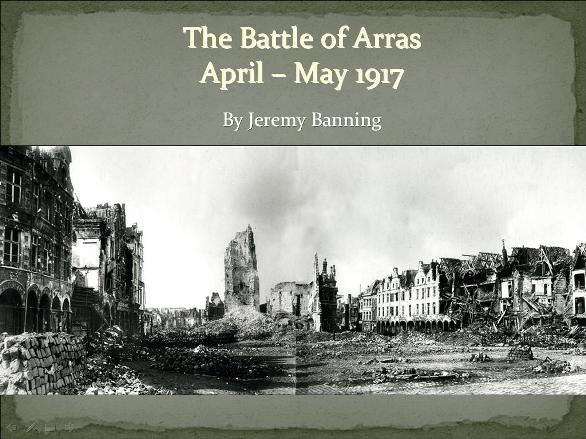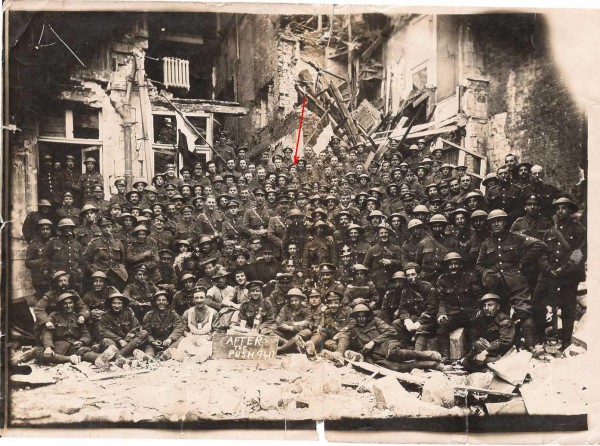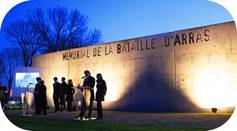Posts Tagged ‘Scarpe’
The Battle of Arras: April-May 1917 – my recent talk at Avon WFA
Last Wednesday (19 October) I spoke at my local branch of the Western Front Association. The subject was one dear to my heart – “The Battle of Arras: April-May 1917”. It was the same talk that I gave to the Berkshire branch of the WFA back in April – see this BLOG article. This time I was allowed a bit longer and so spoke for 45 minutes which took us through the reasons for battle, political intrigues, German retreat to the Hindenburg Line, preparations, work of the RE and artillery and then a detailed look, division by division, working down the line on 9 April 1917 – the first day of battle. After a pleasant ten minute break I continued for a further half hour with details of the fighting for Monchy-le-Preux, Infantry Hill, Roeux and the Chemical Works and Gavrelle before culminating in a description of the disastrous 3 May attack – an attack on a 21km frontage in which 5,900 men were killed in a single day.
It was lovely to speak on ‘home’ turf; the branch in Kingswood being a mere ten minute drive from my house. I do my utmost to attend the monthly lectures but work and family life normally get in the way so it was nice to actually make it this time. It was good to see people had driven from Devon and Newport and I thank them for their interest and support. This morning I received a letter from Dr Barry Maule on behalf of the Avon branch.
“I am writing on behalf of the Bristol branch of the WFA to thank you most sincerely for the excellent talk you gave us on Wednesday evening on the Battle of Arras. You probably gathered from the buzz in the room after your talk that it was particularly well received and very much appreciated by those of our members who share your view that the Arras battles deserve to be much better known.
From experience I can always tell when a talk has been well received by our members because they are reluctant to clear off home afterwards, something that was particularly noticeable on Wednesday evening.
I am sure our chairman spoke for everyone in the room when he described your talk as absolutely tremendous.”
I raffled a copy of our Arras panorama volume and raised a nice sum for the La Boisselle Study Group. Many thanks to all who attended for their generosity. Should anyone be interested in hearing this or other talks then please contact me.
I spoke at the Thames Valley Branch of the Western Front Association (WFA) last Thursday (28 April). When first approached I had to choose between speaking about the Livens Large Gallery Flame Projector on the Somme or the subject of our last book, The Battle of Arras. I opted for the latter, mainly because I figured that the Channel 4 Time Team programme would have been only shown a short time before and so many of those attending would know at least the gist of the story. So, Arras it was. The talk was to last for about an hour (as it was, I think I spoke for nearer 70 minutes) and so this necessitated a good deal of reading to refresh the memory. I prepared a PowerPoint presentation to illustrate some aspects of the talk and managed to get panoramas to slowly scroll across the screen too (a technical feat I was quite pleased with!)
The talk was entitled “The Battle of Arras: April – May 1917? and was well attended with about 45 people regulars plus my brother Mark Banning and his friend and regular battlefield companion Malcolm Sime.
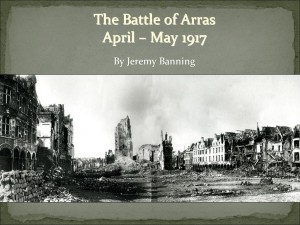 It was structured to not merely cover the battle but start with warfare in the Arras area in October 1914, look at the costly French actions of 1915 and then move on to British occupation in March 1916. The German attack against the 47th (London) Division on Vimy Ridge was touched upon and then I covered a basic backdrop to battle from the political and military standpoint and explained in detail the new German policy of ‘elastic defence’ to be brought into play for 1917. Moving through the Chantilly and Calais conferences I then spent some time on the German retreat to the Hindenburg Line (Operation Alberich) before exploring preparations for battle such as the tremendous work of the Royal Engineers. I also looked into French preparations, the actions of General Robert Nivelle and the extraordinary series of leaks and security lapses that marred the French pre-battle period. By this time half an hour had gone but I felt it important to set the scene fully and not merely delve straight into the battle itself.
It was structured to not merely cover the battle but start with warfare in the Arras area in October 1914, look at the costly French actions of 1915 and then move on to British occupation in March 1916. The German attack against the 47th (London) Division on Vimy Ridge was touched upon and then I covered a basic backdrop to battle from the political and military standpoint and explained in detail the new German policy of ‘elastic defence’ to be brought into play for 1917. Moving through the Chantilly and Calais conferences I then spent some time on the German retreat to the Hindenburg Line (Operation Alberich) before exploring preparations for battle such as the tremendous work of the Royal Engineers. I also looked into French preparations, the actions of General Robert Nivelle and the extraordinary series of leaks and security lapses that marred the French pre-battle period. By this time half an hour had gone but I felt it important to set the scene fully and not merely delve straight into the battle itself.
I structured the actual battle part of the talk by focussing on the First and Third Army fronts from north to south, starting with the Canadian Corps attack on Vimy Ridge before moving into what I always think of the main ‘Arras proper’ battlefield. Realising that no talk about the Battle of the Somme would neglect to work its way down the front line for 1 July 1916 I adopted the same structure – following each division’s success (or failure) as we moved southwards across the Scarpe and Arras-Cambrai road into Hindenburg Line territory until ending with the 21st Division at the south of the attacking frontage. Explaining the reasons for success in many sectors and failure in others I then worked my way through the battle focussing on stand-out actions. These included the capture of Monchy-le-Preux on 11 April 1917 and the destruction of the cavalry of the Essex Yeomanry and 10th Hussars in the village.
I also covered the attack by two battalions of the 10th Brigade (4th Division) towards the village of Roeux and the Chemical Works. 1/Royal Irish Fusiliers and 2/Seaforth Highlanders suffered grievous losses in the attack; the Seaforths attacked with 12 officers & 420 Other Ranks and their losses were all 12 officers & 363 O.R. This meant that a mere 57 men survived the action unwounded – and the objective wasn’t gained in any way. The beautiful Seaforths Cross on the Sunken Lane at Fampoux is a reminder of the men who attacked and suffered so much that day. I touched on the fighting at Bullecourt that day but felt that the disastrous actions around that particular salient village warranted a talk of their own.
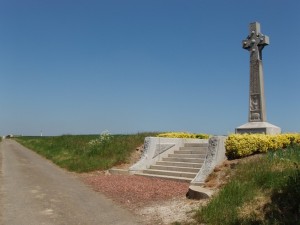 The next attack to be looked into was the attack up Infantry Hill by the Newfoundland Regiment and 1/Essex Regiment on 14 April 1917 – an attack that almost destroyed both battalions and which left the way open for the German reoccupation of Monchy. The day was saved by a gallant band of men led by Lt Col James Forbes Robertson, CO of the Newfoundlanders who organised a small group of men to run to eastern buy discount ambien edge of village and open rifle fire. For five hours their fire held the Germans at bay until the village was relieved. All were decorated and became known as ‘The Men Who Saved Monchy’.
The next attack to be looked into was the attack up Infantry Hill by the Newfoundland Regiment and 1/Essex Regiment on 14 April 1917 – an attack that almost destroyed both battalions and which left the way open for the German reoccupation of Monchy. The day was saved by a gallant band of men led by Lt Col James Forbes Robertson, CO of the Newfoundlanders who organised a small group of men to run to eastern buy discount ambien edge of village and open rifle fire. For five hours their fire held the Germans at bay until the village was relieved. All were decorated and became known as ‘The Men Who Saved Monchy’.
I then worked through the month of April, looking at the failed French attacks on the Aisne and then explaining the movements of 23 April (Second Battle of the Scarpe) with particular emphasis on the fighting for Roeux and the Chemical Works by the 51st (Highland) Division. The battle was deteriorating against well organised and deployed German troops employing the new ‘elastic defence’ doctrine. It was a dreadful time – Third Army suffered 8,000 casualties alone on the 23rd/24th April.
It seemed apt giving the talk on 28 April as I then touched on the attack that day 94 years ago and the capture of the village of Arleux. It was building to the climax of battle – the Third Battle of the Scarpe on 3 May 1917 – a very dark day indeed for the British Army. The 21km frontage from Fresnoy in the north to Bullecourt (again) in the south lent itself to particular problems. The Australians at Bullecourt wanted a night attack to aid their chances of success – in the north this would have been disastrous for the attack on Oppy Wood. A miserable compromise was reached and Zero Hour was set for 3.45am – the attack was still to go in at night time. It was a terrible fiasco – many units were unable to even find their starting points and had no idea of direction to attack, merely following the direction of the artillery barrage with the hope of finding some Germans. Accounts mention morale being poor and a general malaise amongst the depleted attacking divisions. I read from the Official History: Military Operations France and Belgium 1917 by Cyril Falls as it summed up most eloquently the reasons for failure on 3 May 1917:
“The confusion caused by the darkness; the speed with which the German artillery opened fire; the manner in which it concentrated upon the British infantry, almost neglecting the artillery; the intensity of its fire, the heaviest that many an experienced soldier had ever witnessed, seemingly unchecked by British counter-battery fire and lasting almost without slackening for fifteen hours; the readiness with which the German infantry yielded to the first assault and the energy of its counter-attack; and, it must be added, the bewilderment of the British infantry on finding itself in the open and its inability to withstand any resolute counter-attack.”
I concluded with the finals stages of battle, the loss of Fresnoy and eventual capture of Roeux and the Chemical Works and for my last slide whilst talking about the men who had done the fighting I showed one of my favourite pictures. It shows a triumphant shot of a group of the 12/West Yorkshire Regiment in Arras celebrating their success of 9 April with captured booty. I was amazed when a man in the front put his hand up, saying he had spotted his grandfather in the photo! Apparently the only wartime souvenirs that his grandfather left were his medals and a copy of this photo. The man was 50496 Acting Corporal John Davison Johnson (marked with a red arrow in the photo) and I thank his grandson, John Johnson for this information – it quite made my night!
All feedback received has been good and the Branch Chairman, Bridgeen Fox, wrote very warmly afterwards with her thanks. Her comments can be read here. As she herself said, “it should have raised the profile of the battles of Arras and I hope it will have encouraged more people to explore the area”.
When I have some time I will write a blog piece with detail about the 3 May fighting. My thanks to Geoff Sullivan from the wonderful ‘Geoff’s Search Engine’ for furnishing me with some tremendous statistics for that day. If anyone is intersted in hearing this talk then please contact me. I am speaking on this subject in Bristol in October – see here for details. For those with an interest in the battle our panorama book on the subject is available here. Alternatively, if you are interested in a battlefield tour to Arras then please contact me – I would be happy to discuss.
I had been invited to attend the annual service of commemoration for the Battle of Arras at the Wellington Quarry and had written a blog piece about the impending service which had been picked up by the WFA for inclusion on their website. Sadly I was unable to attend due to family commitments but I have been sent images and details of the event by Isabelle Pilarowski of the Wellington Quarry. The service is held at 0630hrs on 9 April each year. The early start is due to the start of battle in 1917 – Zero Hour was 5.30am. It is a gathering of people who want to pay their respects for the men involved in the huge British offensive at Arras in April and May 1917. So often overshadowed by the Battles of the Somme and Passchendaele, Arras stands as one of the three major British offensives of the war.
 I have a huge soft spot for the place, as a battlefield and a superb town to visit, and enjoy the quiet surroundings without the hordes of coaches and resulting pilgrims that can often be seen in some of the more popular battlefield stops on the western front.
I have a huge soft spot for the place, as a battlefield and a superb town to visit, and enjoy the quiet surroundings without the hordes of coaches and resulting pilgrims that can often be seen in some of the more popular battlefield stops on the western front.
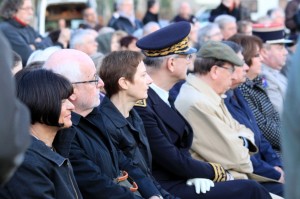 Isabelle tells me that the service went very well and that it was well attended by officials and visitors alike. Attendees included the Mayor, the Préfet, the Ambassador of New Zealand, representatives from Australia and Canada [denoting their countries role in the Battle – at Bullecourt and Vimy] as well as members from other French and British associations.
Isabelle tells me that the service went very well and that it was well attended by officials and visitors alike. Attendees included the Mayor, the Préfet, the Ambassador of New Zealand, representatives from Australia and Canada [denoting their countries role in the Battle – at Bullecourt and Vimy] as well as members from other French and British associations.
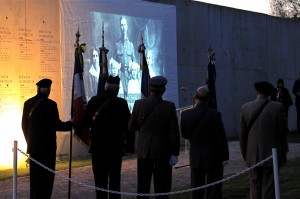 Of particular interest to me was the inclusion of extracts from the wonderful memoirs of Percy Clare, 7th East Surrey Regiment. As part of the 12th (Eastern) Division his battalion attacked up Observation Ridge on the first day of battle. After a rest in the middle of April the battalion was back in the line for the disastrous attacks of 3 May 1917 (Third Battle of the Scarpe) – 94 years ago today. The day is one of the blackest days for the British Army in the Great War and was a hideous muddle from its inception to its execution. Over 5,900 men were killed that day as the attack was repulsed with ease along the vast majority of the Thurd Army front. Very kindly the copyright holder, Rachel Gray, had let me copy a set of Percy’s memoirs for donation to the Wellington Quarry. They are probably the finest account extant of the battle and were quoted through the service. The service also included a reading of the poem ‘The Owl’ by Edward Thomas. He was killed on the morning of 9 April 1917 by a shell blast and is buried in Agny Military Cemetery:
Of particular interest to me was the inclusion of extracts from the wonderful memoirs of Percy Clare, 7th East Surrey Regiment. As part of the 12th (Eastern) Division his battalion attacked up Observation Ridge on the first day of battle. After a rest in the middle of April the battalion was back in the line for the disastrous attacks of 3 May 1917 (Third Battle of the Scarpe) – 94 years ago today. The day is one of the blackest days for the British Army in the Great War and was a hideous muddle from its inception to its execution. Over 5,900 men were killed that day as the attack was repulsed with ease along the vast majority of the Thurd Army front. Very kindly the copyright holder, Rachel Gray, had let me copy a set of Percy’s memoirs for donation to the Wellington Quarry. They are probably the finest account extant of the battle and were quoted through the service. The service also included a reading of the poem ‘The Owl’ by Edward Thomas. He was killed on the morning of 9 April 1917 by a shell blast and is buried in Agny Military Cemetery:
For further details of Percy Clare please see this blog piece or consult our book Arras: The Spring 1917 Offensive in Panoramas Including Vimy Ridge and Bullecourt

